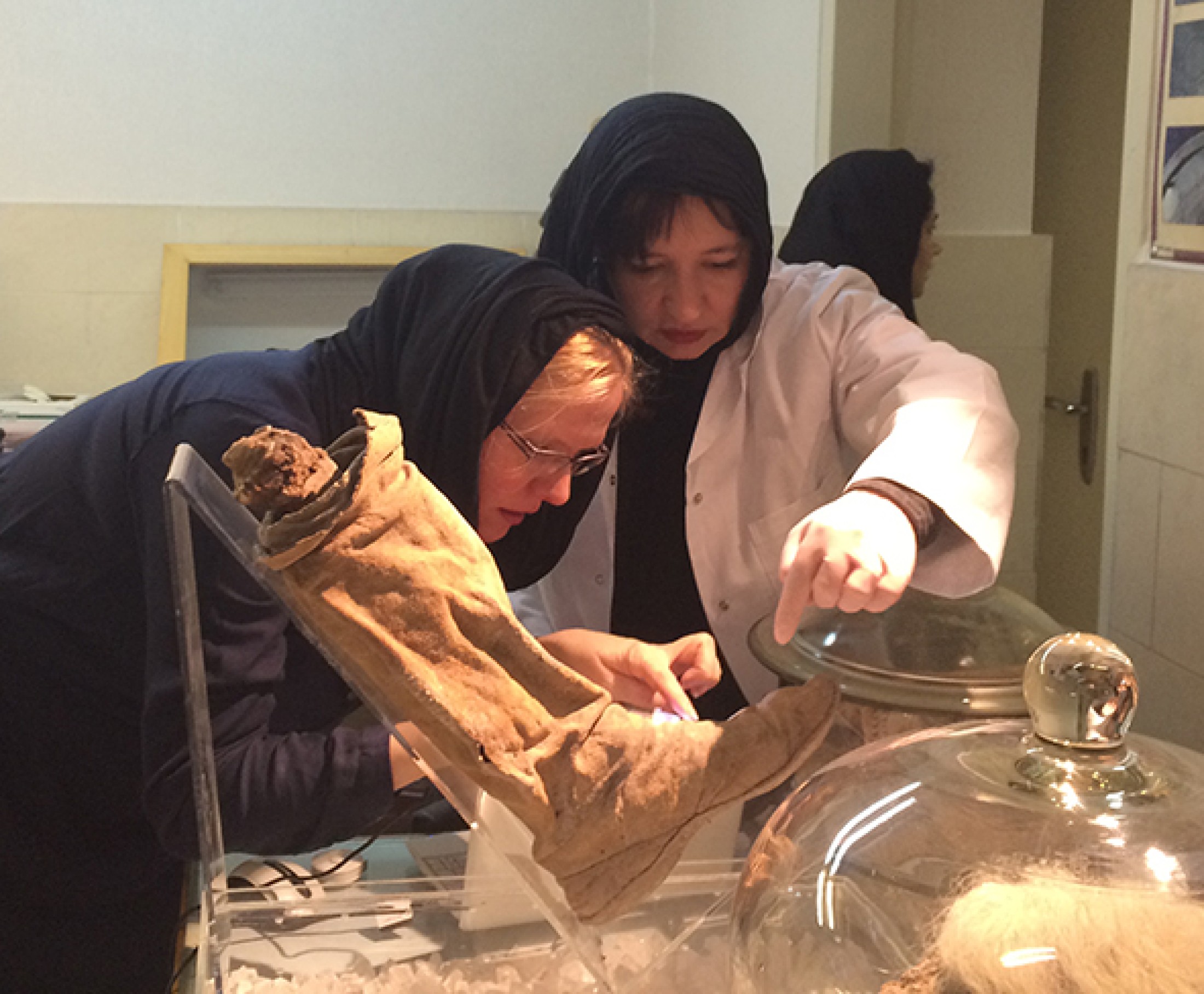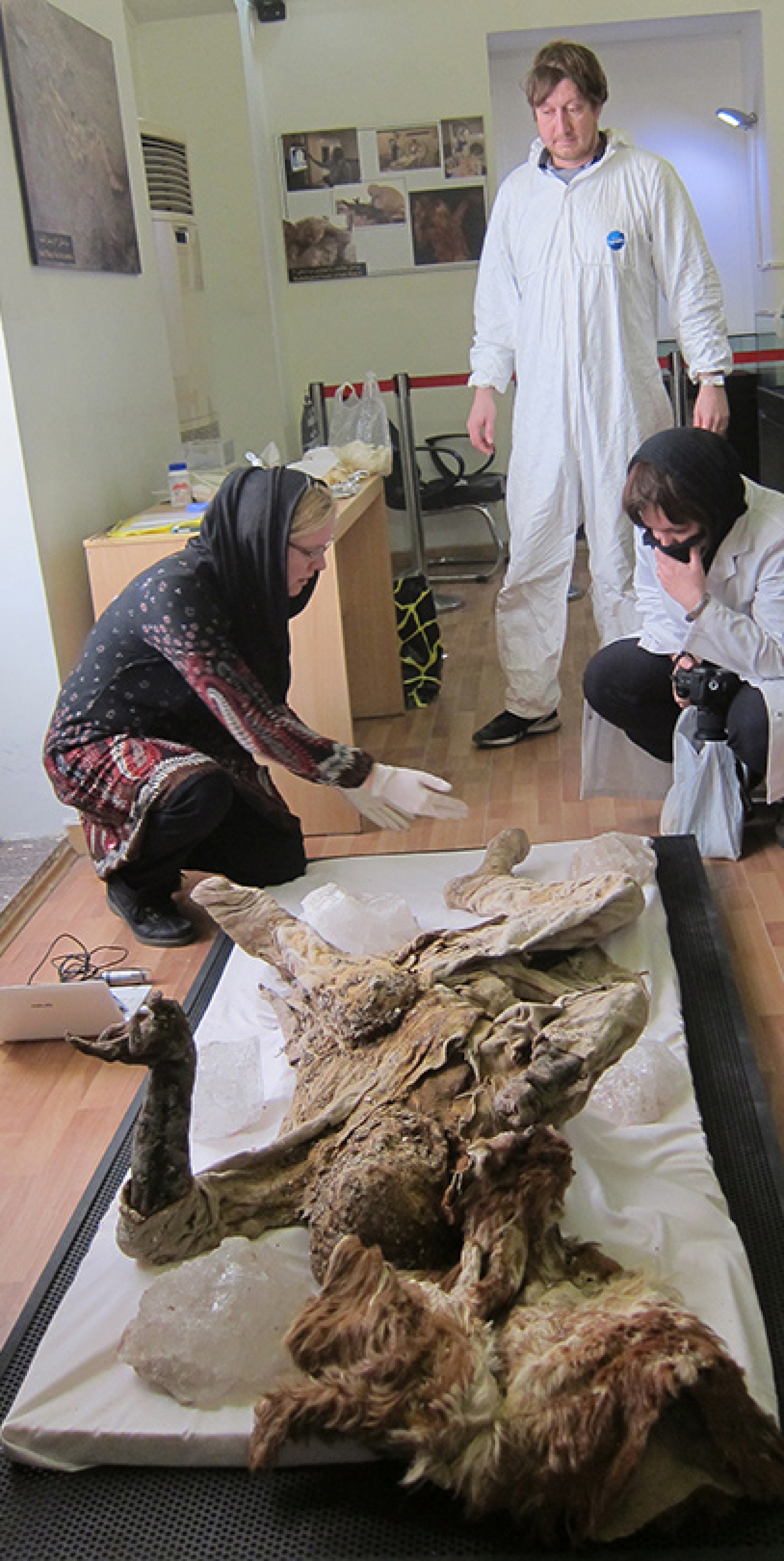The Iranian salt mine of Chehrābād contained the remains of ancient mummified miners who died in a mining accident between
1300 and 2400 years ago. This tragic incident gave rise to a unique opportunity for scientists which led to international
projects.
Researchers travelled to Tehran and Zanjan in Iran in October and December 2015 to examine six salt mummies dating from the period between 400 BC and 600 AD. The experts used their knowledge from Hallstatt on prehistoric salt-preserved textiles to analyse the structure and design of the fabrics.
This project, which builds on the work of the previous Salt Men of Iran project, has the twin aims of preserving the objects found in the mines and designing an exhibition to showcase the discoveries. Key project partners include the German Mining Museum in Bochum, the Archaeological Museum Frankfurt, the Roman-Germanic Central Museum in Mainz, the Natural History Museum in Vienna and the Iranian Zolfaghari Museum Zanjan and National Museum of Iran in Tehran.
The project strives to preserve extraordinary organic finds and mummies from Iran using the latest conservation techniques and at the same time raise awareness among the public on the archaeological significance of these objects dating from the Achaemenid and Sassanid periods. Most of the finds are housed in the Zolfaghari Museum in Zanjan in western Iran. These are significant discoveries which have provided important scientific evidence to date and which play a major role in the identity of an entire region. Within the framework of this project the Iranian experts will receive training and support over several years both in Germany and on-site in Iran. The project will include a conservation and monitoring concept as well as structural and technical measures to ensure the objects are stored and exhibited appropriately. Exhibitions are planned to be held in Teheran, Frankfurt and possibly other places. For this, the finds will be restored and scientifically analysed in order to present them in their full context. These conservation measures and the development of a new concept for the permanent exhibition in Zanjan as well as special exhibitions in Tehran and Germany will preserve this important cultural heritage and raise its profile both in Europe as well as in the province of Zanjan through a partnership bringing together German, Austrian and Iranian institutions.
2015 - 2017: „Saltmen Iran - Chehrabad Saltmummy & Saltmine Exploration Project“
The internationale Research Project was funded by the German Research Society and was led by Dr Thomas Stöllner from the Ruhr University Bochum/Mining Museum Bochum and Abolfazl Aali from the Zolfaghari Museum Zanjan.Researchers travelled to Tehran and Zanjan in Iran in October and December 2015 to examine six salt mummies dating from the period between 400 BC and 600 AD. The experts used their knowledge from Hallstatt on prehistoric salt-preserved textiles to analyse the structure and design of the fabrics.
2018 - 2020: "The Salt Men of Iran: The Cultural Heritage of the Salt Mummy Museum in Zanjān"
The international research project "The Salt Men of Iran: Chehrābād Salt Mummy & Salt Mine Exploration Project", which ran from 2015 to 2017, was supplemented in 2017 by a further research project financed by the German Gerda-Henkel-Foundation until 2020.This project, which builds on the work of the previous Salt Men of Iran project, has the twin aims of preserving the objects found in the mines and designing an exhibition to showcase the discoveries. Key project partners include the German Mining Museum in Bochum, the Archaeological Museum Frankfurt, the Roman-Germanic Central Museum in Mainz, the Natural History Museum in Vienna and the Iranian Zolfaghari Museum Zanjan and National Museum of Iran in Tehran.
The project strives to preserve extraordinary organic finds and mummies from Iran using the latest conservation techniques and at the same time raise awareness among the public on the archaeological significance of these objects dating from the Achaemenid and Sassanid periods. Most of the finds are housed in the Zolfaghari Museum in Zanjan in western Iran. These are significant discoveries which have provided important scientific evidence to date and which play a major role in the identity of an entire region. Within the framework of this project the Iranian experts will receive training and support over several years both in Germany and on-site in Iran. The project will include a conservation and monitoring concept as well as structural and technical measures to ensure the objects are stored and exhibited appropriately. Exhibitions are planned to be held in Teheran, Frankfurt and possibly other places. For this, the finds will be restored and scientifically analysed in order to present them in their full context. These conservation measures and the development of a new concept for the permanent exhibition in Zanjan as well as special exhibitions in Tehran and Germany will preserve this important cultural heritage and raise its profile both in Europe as well as in the province of Zanjan through a partnership bringing together German, Austrian and Iranian institutions.

Untersuchung eines 1600 Jahre alten Stiefels aus Chehrabad im Nationalmuseum Teheran

Untersuchung von Salzmann 4 im Museum Zanjan

